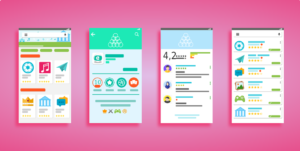The rate of mobile internet usage has increased exponentially in recent years with mobiles now accounting for more than half of the total online traffic worldwide. For companies who want to reach their target demographic, having a mobile app and mobile-friendly website is essential.
Of course, your mobile app will only be successful if it provides value to users. Regardless of what products you sell or services you deliver, your app needs to attract and engage users if you want them to use it.
The success of a mobile app lies in the development process. With the right expertise and innovation, developers can create new and exciting apps that enable their clients to achieve their objectives. To learn how, we take a look at the steps every mobile app developer should follow.
1. Design: the path to creating an award-winning mobile app
The first step to creating an award-winning app is the design process. During the early stages of mobile app development, you’ll commence formulating your ideas and progress from initial ideation to information architecture and wireframing—designing your mobile app from the ground up.
Most developers work closely with their client throughout the ideation stage—a process which allows clients provide insights to the developer as to how they envisage their app and an understanding of what they want to achieve, how users will engage with the app and the purpose the app serves.
Information architecture, or IA, refers to an outline of the content your app will offer. No matter how momentous your content may be, it must presented in a user-friendly way for the app to be popular. By focusing on IA from the outset, developers and designers are making user experience (UX) an inherent element of the app.

Similarly, wireframing allows designers to map out how users will navigate through the app. Wireframes can be hand-drawn at the start of the design process and progress to digital form as the design process gets underway. The increased accuracy and detail achievable with digital wireframes allow developers to mock-up the app in greater detail.
Furthermore, the use of variable digital wireframes enables developers to determine how a design will look and function on different mobile devices and platforms.
2. Development: functionality and useability the key to uptake
Once the design is finalised and approved by the client, the developer can get to work building the app. Firstly, the database must be selected—the type of database chosen will determine what data is synchronised via the app and what offline functions the app will perform. The decisions made early in the development stage impact on the app’s functionality and useability.
Similarly, the application program interface, or API, needs to be created. An API build can be one of the most technically challenging elements of the build process, but it needn’t be too much of an obstacle for talented developers. While experience inevitably helps developers create more robust APIs, the ability to leverage the client’s needs and expectations with UX and tech capabilities is most important.
Both the database design and API build facilitate the backend development of the app, but developers must also focus on creating the app itself. Once the API build and database is complete, the remaining elements of the app build bring them together and create a user-friendly, functional platform.
3. Test and Deploy: Identifying and fixing bugs before launch
As an experienced developer knows, testing is essential when creating any application. Bugs or glitches are inevitable in any build, but thorough examination can identify these issues before launch and allow you to resolve them. Clients often feel comprehensive testing is unnecessary, but savvy developers will always factor in time for rigorous testing.
The most effective way to test mobile apps is to check each development stage—regular testing ensures issues identified are resolved immediately, minimising the time it takes to fix bugs and possibility of faults being overlooked later. By testing prototypes at every stage of the build, for example, you’ll be able to identify potential issues as they arise, rather than at the end of the build.
Something often overlooked is the need to thoroughly test your app across all platforms and devices to ensure the best possible user experience.
Once the mobile app build is complete and thoroughly tested, developers can release the product to the client for deployment. In most cases, however, developers will play an active role during the launch phase with clients often requesting you’re on hand to assist with the app launch and to troubleshoot any issues.
Talk with the experts
As you can see, developing functional and innovative mobile apps requires experience and expertise. Fortunately, you don’t have to create a winning app alone. As one of the leading mobile app developers in Australia, Rocket Lab can provide your business with experience and technical expertise you require.
Whether you’re struggling to think of new ideas for your app, you’re unsure what API to use, or you need help testing your product, Rocket Lab is available to provide the expert advice in every stage of your journey. Located in Sydney, they work with clients from all over the globe. From SMEs nearby to global corporations around the world, they have become the first choice for organisations who want to build ground-breaking cross-platform solutions for mobile devices.